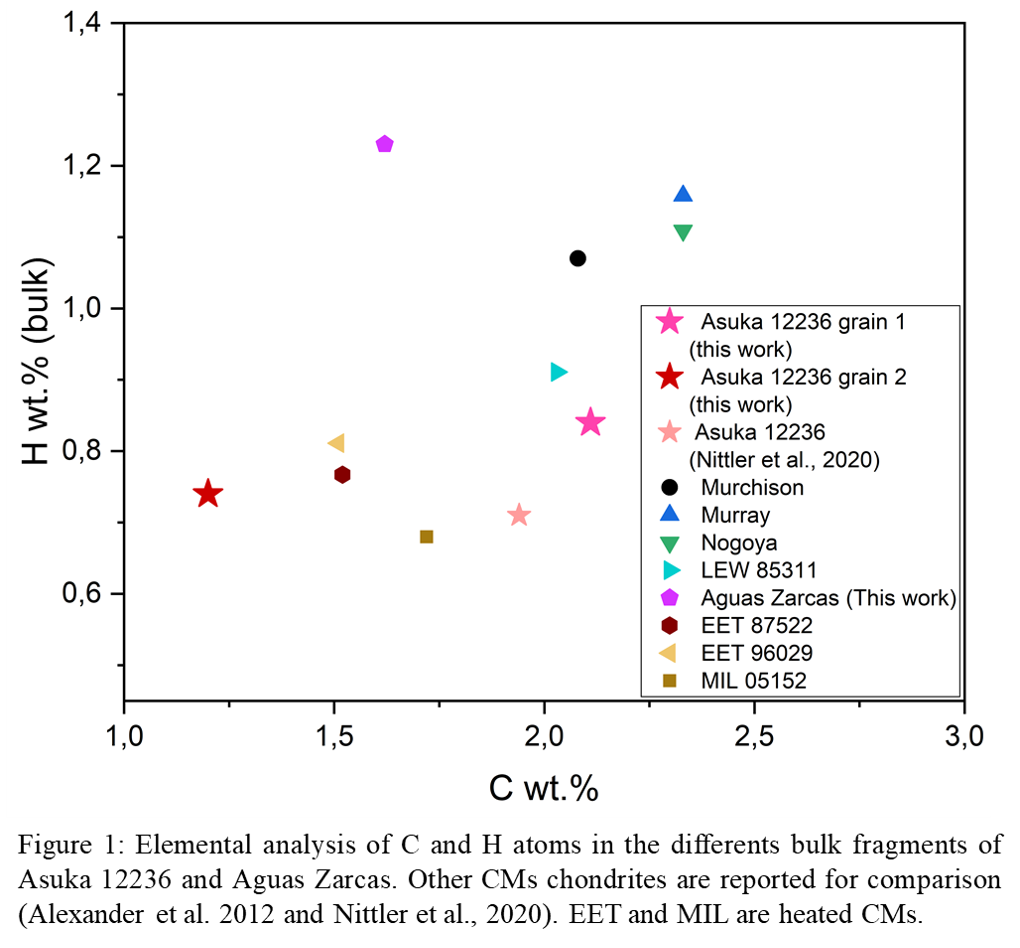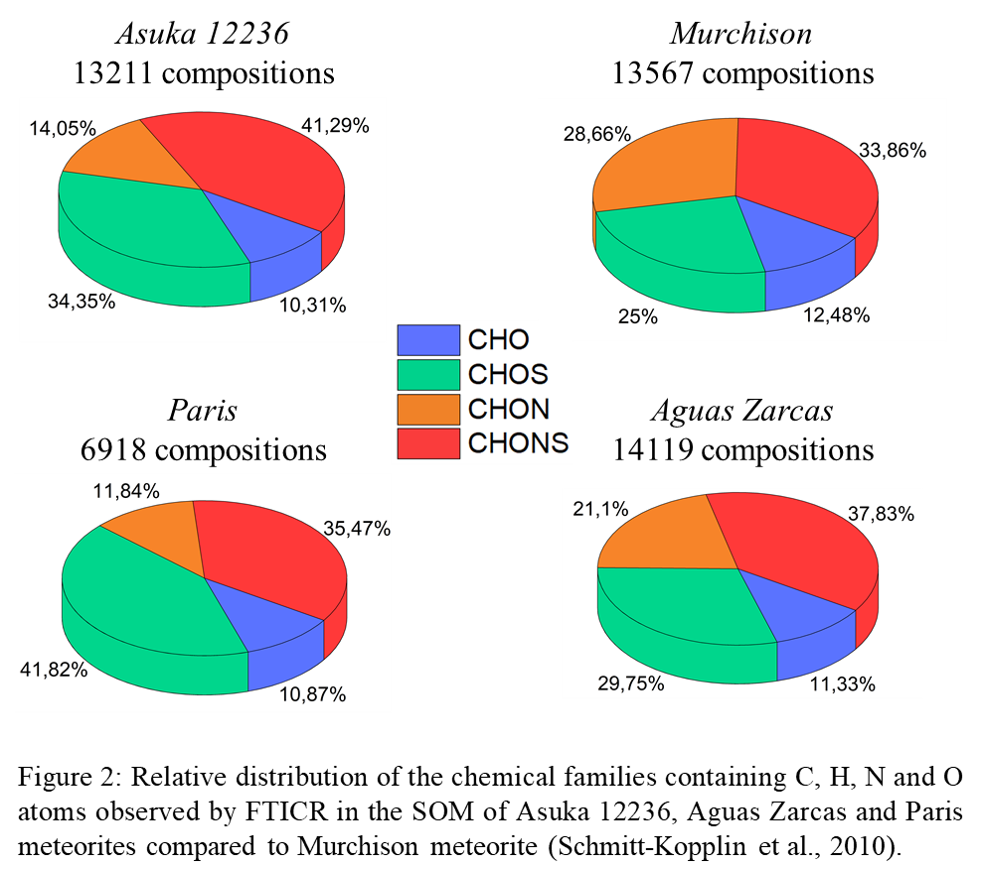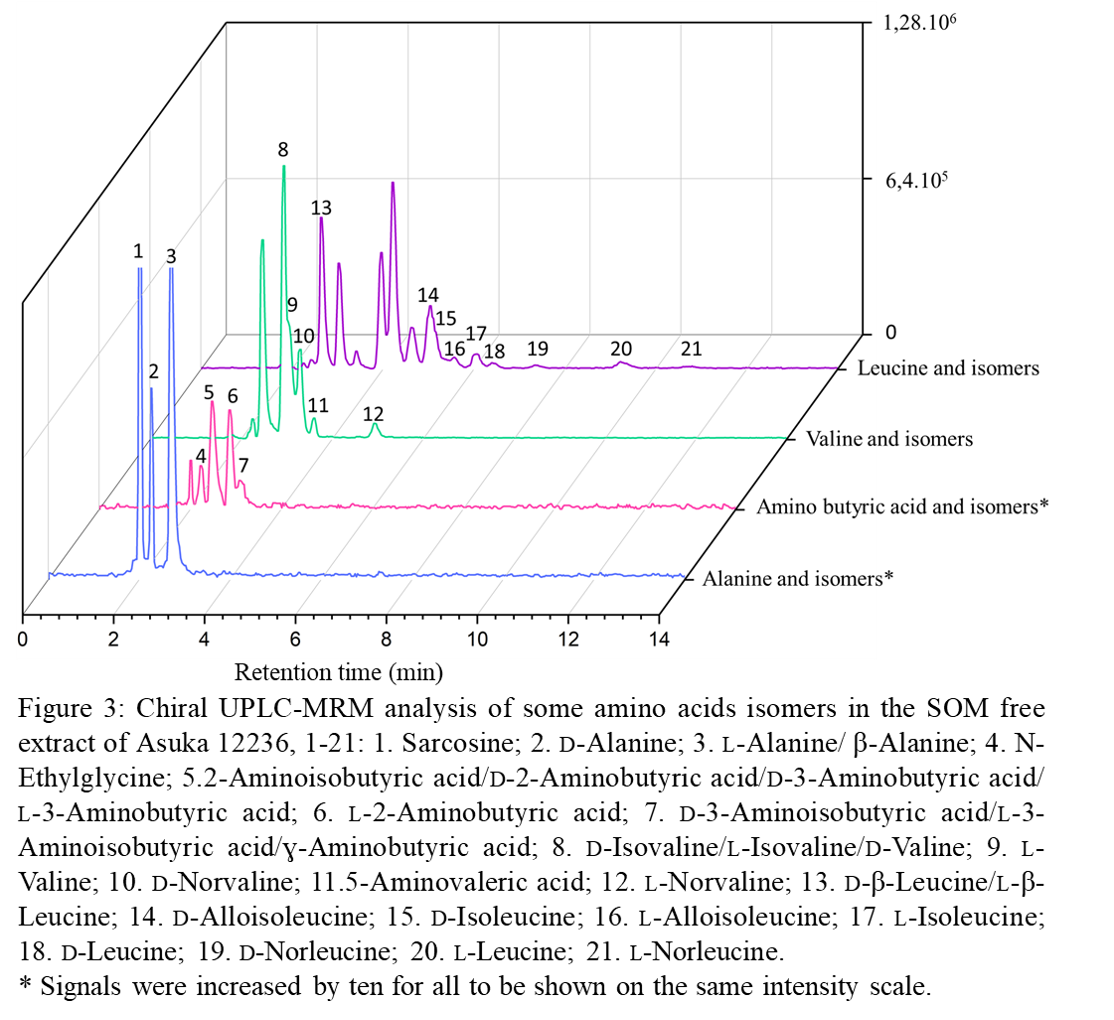Overview of the organic matter present in Asuka 12236: a primitive meteorite?
- 1Université Aix-Marseille, UMR CNRS 7345, PIIM, Institut Origines, Marseille, France
- 2Université Poitiers, UMR CNRS 7285 , IC2MP, Poitiers, France
- 3Technical University Munich, School of Life Sciences, Freising,Germany
- 4Helmholtz Munich, BGC, Munich, Germany
Introduction: Meteorites, which are the remnants of our protoplanetary disk, provide a rich source of chemical information to investigate the origin of organic matter that have fallen on Earth and may have thus contributed to the emergence of life. Among meteorites, carbonaceous chondrites that contain organic matter are among the most primitive materials in the Solar System. Asuka 12236, found in Antarctica in 2012, has been classified as a member of the CM group. According to the first mineralogical analyses (Kimura et al., 2020, Nittler et al., 2021), Asuka 12236 is among the most primitive member of this group showing very few signs of aqueous alteration in its mineralogy.
Here, we have performed an overview of the soluble organic matter (SOM) present in this primitive meteorite, and compared it with other carbonaceous chondrites of the same family group. Two types of analysis were carried out on the SOM: a non-targeted analysis and then a targeted one on the basic so-called building blocks of life such as nucleobases and amino acids.
Methods: At first, we measured the global carbon content of our samples by elemental analysis using two grains of 2 mg each.
For the non-targeted high-resolution analysis of the SOM, 17 mg of the meteoritic material were used to extract the SOM with solvents allowing the preservation of meteorite organics (Schmitt-Kopplin et al. 2010). The fragment was crushed and successively extracted with dichloromethane, hexane and methanol at room temperature. The extracts were analyzed by FTICR (Fourier-Transform Ion Cyclotron Resonance) within a mass range of 150-1000 m/z.
For the analysis of the amino acids and nucleobases, 226 mg were extracted in water for 24h at 100°C. Aliquots were collected after centrifugation. Two UPLC-MS analyses have been performed (Serra et al., 2022) on these aliquots: the first was a screening from 50 to 750 m/z done with a Q-exactive Orbitrap coupled with a HILIC column. The second analysis has been done with a chiral column, allowing separation of targeted amino acids and information on a possible enantiomeric excess. This chiral analysis is coupled with UPLC- Multiple Reaction Monitoring (MRM-MS) MS analyses.
Identification and quantification of the molecules were done by dosed addition using 54 amino acids and 5 nucleobases (Adenine, Guanine, Cytosine, Thymine, Uracil), ensuring the right identification of the isomers. Note that our protocol does not include HCl hydrolysis step of the extracts, neither a derivatization procedure.
Results and Discussion: Elemental analysis (EA) done on 2 different fragments reveal the heterogeneity of our sample, in addition to the grains analyzed by Nittler et al., 2020, likely showing different alteration degrees in the chondrite (Fig. 1). We observe a correlation of carbon and nitrogen abundances in all grains of N/C ~ 0.05. From its H content, which can be extrapolated as the quantity of water, Asuka 12236 falls near the less altered CM chondrites, relatively close to the heated ones (EET and MIL CMs) (Alexander et al., 2012), while no sign of heat above 250 °C is observed on its mineralogy (Kimura et al., 2020).

Electrospray ionization in negative mode FTICR analyses of the methanol on Asuka SOM reveal a global chemical composition of C, H, N, and O molecules up to 13211 different formulae (Fig. 2). The CHONS family contains the major chemical compounds for 41 % followed with CHOS family for 34 %. Such sulfur rich compounds can be related to the high abundance of mineral sulfide observed in the Asuka matrix (Kimura et al., 2020) and found by elemental analysis (2.4 wt.%). Compared to others CMs, such as Murchison and Aguas Zarcas, measured with the same instrument, Asuka has a similar SOM diversity with more sulfur organic compounds. The Paris meteorite, also among the least altered chondrites (Marrocchi et al., 2014), has half in amount of compounds with a similar relative abundance in sulfur containing compounds as Asuka in its methanol SOM.

The UPLC-HRMS method allows a rapid screening of small polar molecules. We observe a huge diversity of small compounds (<200m/z), with more intense signals than those obtained from Aguas Zarcas (Serra et al.; 2020).
Target analysis performed with chiral column allow the identification and quantification of roughly 40 different amino acids. None of the natural nucleobases has been firmly identified, but some masses seen by UPLC-HRMS method do correspond to possible nucleobases isomers (Ruf et al., 2019).
Overall, our analysis results in the observation of a very diverse compounds in Asuka 12236, similar to what is observed in more aqueously altered chondrites (Murchsion and Aguas Zarcas). In agreement with Glavin et al., 2020, we confirm the high concentration and diversity of amino acids, together with the identification of new ones in our extract of the meteorite (Fig. 3).

Such diversity, in amino acids and in global molecular composition, in addition to the quite high H wt.% indicates that the OM in Asuka 12236 has likely been altered during aqueous alteration, however still less than Murchison. It is also possible that Asuka 12236 presents more than one lithology, as seen with the three different results by EA, which can be related to the CI/CM clast seen in the matrix (Nittler et al., 2021). The chemical composition of the Asuka 12236 meteorite points toward a very rich and diverse composition but still needs further investigation in comparison to other meteorites to hypothesize on its origin and possible precise degree of alteration by aqueous processes.
Aknowledgements: We thank Philippe Clayes for the Asuka 12236 sample coming from the Asuka collection retrieved by expedition in Antartica by VUB-ULB and the Royal institute of the Natural Sciences in Bruxelles.
This study was partially funded by the Deutsche Forschungs-gemeinschaft (DFG, German Research Foundation) – Project-ID 364653263 – TRR 235 (CRC 235)
References:
Kimura. M. et al., (2020), Polar Science, (26), p100565.
Marrocchi et al. (2014), Meteoritics and planetary science 49.
Nittler et al., (2021), Meteoritics and planetary science 56
Ruf et al., (2019). The Astrophysical Journal Letters, 887
Schmitt-Kopplin. P. et al., (2010), PNAS, 107 (7) p 2763-2768
Serra. C. et al., (2022), Talanta (Oxford), (243), p123324
How to cite: Serra, C., Vinogradoff, V., Poinot, P., Duvernay, F., Le Sergeant d'Hendecourt, L., and Schmitt-Kopplin, P.: Overview of the organic matter present in Asuka 12236: a primitive meteorite?, Europlanet Science Congress 2022, Granada, Spain, 18–23 Sep 2022, EPSC2022-546, https://doi.org/10.5194/epsc2022-546, 2022.

